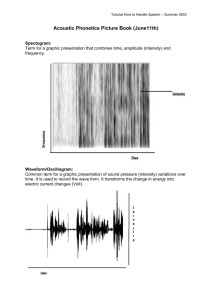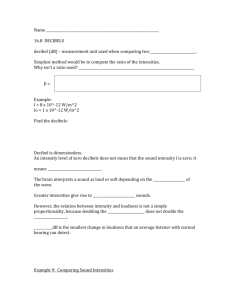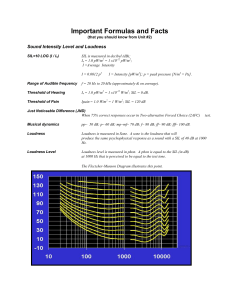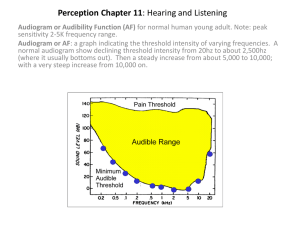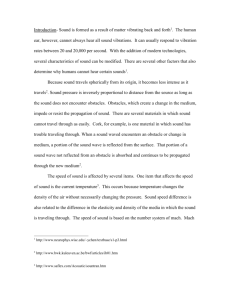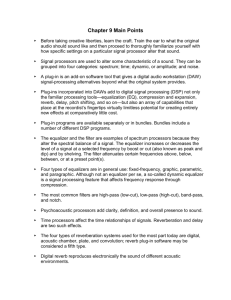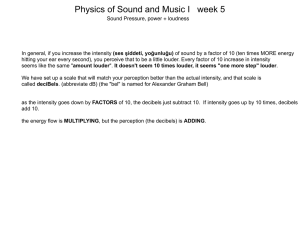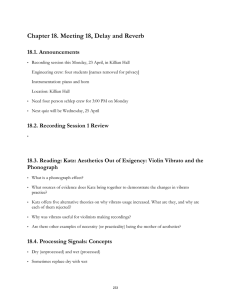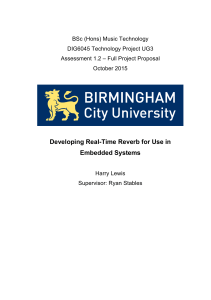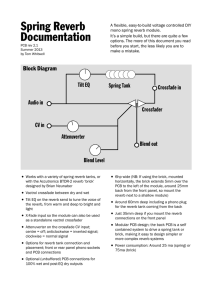Physics of Sound Part 2
advertisement
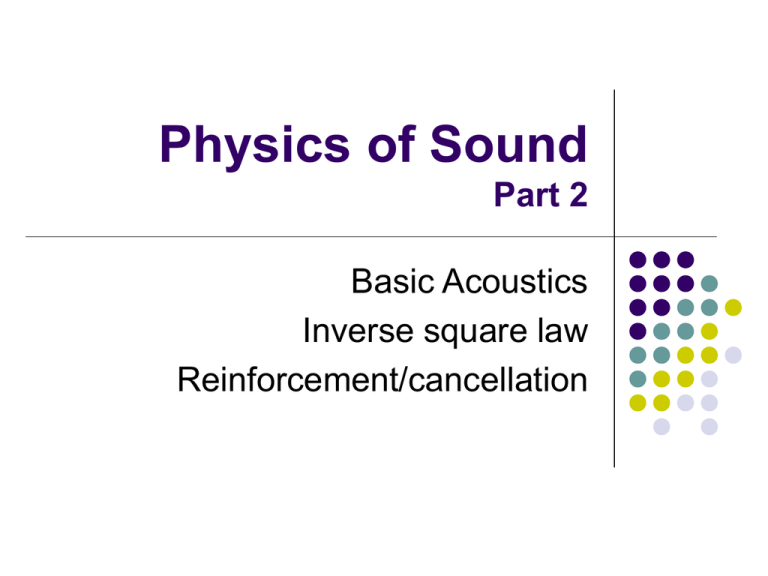
Physics of Sound Part 2 Basic Acoustics Inverse square law Reinforcement/cancellation Interference Phase measurement of where the amplitude of a wave is relative to another wave A cycle can start at any point in a waveform Two waves with the same frequency can start at different times Measured as an angle in degrees Related to the sine wave representation of the wave Interference Constructive of destructive interference Waveforms will add by summing their signed amplitude at each instant in time Beats Happens when two slightly different frequencies interfere Often used in tuning Standing waves When sound waves bounce off of obstructions, they can interfere with themselves Tends to reinforce some frequencies and attenuate others Prevented by using Non- Parallel walls, ceilings Convex surfaces Multi-level ceiling sections Reverberance (Reverb) Consisting of multiple, blended sound images caused by reflections from walls, ceilings and other structures which do not absorb sound NOT echo Echo consists of individual, non-blended sound images Reverb time is related to The time it takes for a sound to reduce to an inaudible level Loudness of sound relative to background noise Ratio of loudness of reverberant to direct sound Short reverb time (less than 1.5 sec) is better for speech or drama Long reverb time (more than 1.5 sec.) is better for music Absorption Controlling reflections can reduce or increase reverb time Air tends to absorb frequencies above 2K Hz Sight line obstructions Frequencies above 10 kHz tend to not bend around corners well or other obstructions l=1.3 inches for 10 kHz tone Frequencies below 1kHz do very well l=5.65 feet for 200 Hz tone Specialists are often hired to “tune” a space acoustically Acoustic attributes Defined by Leo Beranek after a 6 year study of 54 concert halls Used to define acoustic properties in terms that other trained professionals can understand Acoustic attributes Intimacy – Indicates the size of a room How it sounds to the listener, not actual size Determined by the initial-time-delay-gap (ITDG) Interval between the sound that arrives directly at the ear and the first reflection Usually considered to be the most important attribute Acoustic attributes Liveness Related to Reverberance Room size is related More reflections is live. Less reflections is dry or dead Warmth More low frequency sound relative to mid frequency Too much low frequency sound is said to be “Boomy” Acoustic attributes Loudness of direct sound Inverse square law Loudness of sound will decrease by one quarter every time the distance from the source is doubled Definition or Clarity Good definition when sound is clear. Related to intimacy, liveness, loudness of direct and reverberant sound Acoustic attributes Brilliance A hall that has liveness, clarity and intimacy Diffusion Relates to the orientation of reverberant sound Where is the reflected sound coming from It is preferable to have reverb sound coming from all directions Intensity Like pitch, loudness is a sensation in the consciousness of a listener To produce a sound twice as loud requires 10 times the power Inverse square law Sound level is reduced by a factor of the square of the distance away from the source If you move double the distance from the source, the sound intensity will by one quarter Intensity Intensity is a measurable quantity SPL – Sound Pressure Level dB – deciBel A system of measuring a ratio between two powers dB (spl)=20log(P1/p0) p0 is a reference level, usually taken to be the minimum intensity audible to an average person – “Threshold of Hearing” 3 dB change is hardly noticed as a change 6 dB changes is heard as twice as loud dB SPL Sound 150 dB Jet engine at 1m 140 dB Rock and Roll stack at 1m 130 dB Thunderclap, Air Raid Siren 1 Meter 120 dB Jet takeoff (200 ft) 110 dB Rock Concert 100 dB Train passing up close 90 dB Heavy traffic 80 dB Hair Dryer 70 dB City street 60 dB Noisy bar or restaurant 50 dB Open plan office environment 40 dB Normal conversation level 30 dB Library, Soft Whisper (5 Meter) 20 dB Quiet domestic environment 10 dB Broadcasting Studio, Rustling Leaves 0 dB Threshold of hearing in young adult Sound Envelope Listener does not hear individual cycles of sound waves Attack – Time it takes for sound to rise from nothing to its greatest intensity. Usually short. Decay – Time it takes for a sound to fall from its attack level to its sustaining level. Decay time is usually short Sustain – The time during which the initial vibrating source continues to supply energy to the sound. Usually perceived as the duration and intensity of the sound Release – Time it takes for the sound to drop from its sustain level to inaudibility after vibrating object stops supplying energy For Next Class Read Basic Electricity, Kai’s Sound Handbook P. 23-27, Leonard
